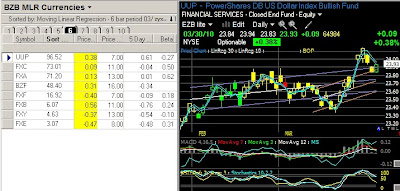 You don't even have to look at the sort results. If you've been watching the Rotators for a while you know that the odds-on favorite, the Qs, are leading the pack as usual. So, it turns out my uber cautious exit was a bit premature yesterday. But I'm not feeling any regrets. . . the $.14 I left on the table from Monday's exit to Tuesday close was more than made up for by an early 90 minute short that netted $.40 using my old reliable VIXEN setup confirmed by both the parabolics and the 3 SMAs.
You don't even have to look at the sort results. If you've been watching the Rotators for a while you know that the odds-on favorite, the Qs, are leading the pack as usual. So, it turns out my uber cautious exit was a bit premature yesterday. But I'm not feeling any regrets. . . the $.14 I left on the table from Monday's exit to Tuesday close was more than made up for by an early 90 minute short that netted $.40 using my old reliable VIXEN setup confirmed by both the parabolics and the 3 SMAs.Considering that the Qs daily ATR has now dropped to .52 (from .54 on Friday) a $.40 daytrade in 90 minutes is more than acceptable. A year ago when I first starting posting this setup we were looking for .01/minute net return as a performance target. That goal became unrealistic months ago . . a reflection of dwindling volatility. Yesterday's trade was a unique and isolated situation, albeit a happy one.
BTW, if you take a look at the midpanel technicals on the Qs Rotator chart you would most likely surmise that the Qs are going __. This view is confirmed by Frank, who has gone far beyond the Blogger's call to duty in preparing his latest multi-system market forecast.

On the currency front the UUP was the star yesterday, clinging to the upper LR30 channel band. As long as the channel remains upslope the prospects for UUP remain positive, so we'll be keeping a close eye on this situation.
Just as a point of reference on the 1/3 ATR trailing stop mentioned last week . . the Qs, with a beta of 1.11 have a daily ATR of $.52, while UUP, with a beta of -.27 has a daily ATR of $.16 so, from a practical standpoint, using 1/3 ATR or $.05 for a trailing stop with UUP is probably more a recipe for frequent premature exits than a smart risk management tactic.














































